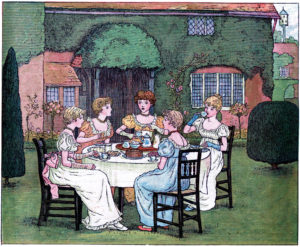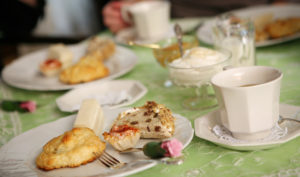The Joyful History of Tea Parties
We’re very lucky to feature guest writer Sandy Lane! Sandy is a longtime tea friend as well as a wonderful human being. Please enjoy her piece on the history of tea parties below!
If you have had the pleasure of attending a tea party at Anna Marie’s Teas in Liberty, Missouri, you may be wondering how tea parties actually got started. It is believed that sometime between the late 1830’s and early 1840’s, taking tea in the afternoon, along with assorted edible treats, became a new English social event which provided some nourishment during the long hours between lunch at n oon and the evening meal. Legend has it that Anna Maria, the 7th Duchess of Bedford, experienced afternoon “sinking feelings” which led her to seek relief from her hunger. She requested her footman to bring to her private room a tray of “tea things” (probably something similar to the Buckingham Breakfast or Kenilworth Estate blends sold by Anna Marie’s) and something to eat, possibly bread and butter and cake. She so enjoyed this refreshing afternoon indulgence that she began inviting her friends to share it with her. Over time, afternoon tea became an enjoyable and well-established event in British countryside villages as well as in the court of Queen Victoria, an enthusiastic tea drinker.
oon and the evening meal. Legend has it that Anna Maria, the 7th Duchess of Bedford, experienced afternoon “sinking feelings” which led her to seek relief from her hunger. She requested her footman to bring to her private room a tray of “tea things” (probably something similar to the Buckingham Breakfast or Kenilworth Estate blends sold by Anna Marie’s) and something to eat, possibly bread and butter and cake. She so enjoyed this refreshing afternoon indulgence that she began inviting her friends to share it with her. Over time, afternoon tea became an enjoyable and well-established event in British countryside villages as well as in the court of Queen Victoria, an enthusiastic tea drinker.
As the years passed, tea party rituals evolved and included such things as tea times and invitations, tea selections, standard menus, equipage (or, “tea things” as Jane Austen referred to them), china, attire, hats, and etiquette. The format, gentility, and popularity of tea parties spread to other countries and cultures, and today, tea parties remain a most pleasant pastime for tea lovers of all varieties.
When you attend a tea part y at Anna Marie’s, you will notice tea tables beautifully set with tablecloths and napkins, china, silverware, decorations, clotted cream and jam. The servers deliver to each table a three-tiered cake stand containing three courses of traditional tea party treats: first, savories, which are usually tiny tea sandwiches; then, scones; finally, sweets, which are an assortment of pastries.
y at Anna Marie’s, you will notice tea tables beautifully set with tablecloths and napkins, china, silverware, decorations, clotted cream and jam. The servers deliver to each table a three-tiered cake stand containing three courses of traditional tea party treats: first, savories, which are usually tiny tea sandwiches; then, scones; finally, sweets, which are an assortment of pastries.
Throughout the tea party, the servers will visit each table to keep tea cups filled from steaming teapots of nicely steeped loose-leaf tea. Brenda Hedrick, owner of Anna Marie’s Teas, strives to create a welcoming, friendly, and satisfying experience for tea party attendees.
If you’re in search of an opportunity to be greeted by some lovely people, to have a relaxed visit with friends or family, to be served delicious tea and tea treats, to spend some time in a grand and gorgeous 1913 historic home . . . come to tea at Anna’s!
Two wonderful books were used in preparing this blog entry:
Tea & Etiquette, by D. Johnson & B. Richardson; and
A Social History of Tea, by J. Pettigrew & B. Richardson
